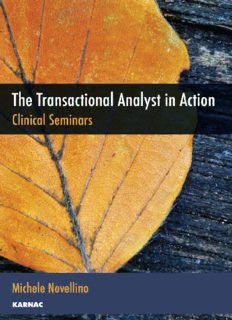
The Transactional Analyst in Action: Clinical Seminars PDF
Preview The Transactional Analyst in Action: Clinical Seminars
CHAPTERTITLE I THE TRANSACTIONAL ANALYST IN ACTION THE TRANSACTIONAL ANALYST IN ACTION Clinical Seminars Michele Novellino First published in English in 2012 by Karnac Books Ltd 118 Finchley Road, London NW3 5HT First published in Italian in 2010 as Seminari clinici. La cassetta degli attrezzi dell’analista transazionale Copyright © 2012 FrancoAngeli srl, Milan, Italy. Translated by Andrew Brociner The right of Michele Novellino to be identified as the author of this work has been asserted in accordance with §§ 77 and 78 of the Copyright Design and Patents Act 1988. All rights reserved. No part of this publication may be reproduced, stored in a retrieval system, or transmitted, in any form or by any means, electronic, mechanical, photocopying, recording, or otherwise, without the prior written permission of the publisher. British Library Cataloguing in Publication Data A C.I.P. for this book is available from the British Library ISBN 978 1 78049 070 0 Edited, designed and produced by The Studio Publishing Services Ltd www.publishingservicesuk.co.uk e-mail: [email protected] Printed in Great Britain www.karnacbooks.com CONTENTS ACKNOWLEDGEMENTS viii ABOUT THE AUTHOR ix PREFACE by William F. Cornell x INTRODUCTION xiv CHAPTER ONE General principles 1 Didactic introduction 2 Definition of transactional analysis 3 Schools of transactional analysis 4 New epistemological bases 6 Social, psychological, and unconscious communication 15 Other recent directions in literature 20 CHAPTER TWO Change in transactional analysis 23 The change 23 The syndrome of the effective psychotherapy 27 v vi CONTENTS Positive feedback 30 Negative feedback 31 The patient who does not change 31 “Sloppiness” 35 CHAPTER THREE Defence and resistance 41 General principles 41 Defence and developmental point of view 45 Counter-resistance. Analysis of countertransference 47 The triadic approach to resistance 51 Resistance in groups and anti-leadership 56 CHAPTER FOUR The clinical methodology 59 Therapeutic plan and methodology 59 Therapeutic contract and analytic contract: 60 operative differences The difference between strategy and tactics 62 Strategic phases of the therapist 62 CHAPTER FIVE The setting 69 Premise: the six steps of the first interview and the 69 setting in transactional psychoanalysis Definition of setting 80 The set-up of the case and the reference 81 The initial request 83 The first interview and the formation of the 84 therapeutic alliance. Alliance and pseudo-alliance Aims of the first interview 86 The motivation of the patient 86 Gathering of information 89 Giving information 90 Contract and probe interventions 91 CHAPTER SIX The therapeutic contract 95 Contract as content and as process 95 Administrative contract 96 CONTENTS vii Soft and hard therapy contracts 97 Unacceptable contracts 100 Therapy without contract 100 Holloway’s contract 101 CHAPTER SEVEN The Bernean methodology 103 The classic Bernean methodology: the therapeutic 103 themes The phases of therapy according to Berne 106 Bernean tactics of intervention on the Adult 108 Tactics of intervention with the Parent 118 Tactics of intervention on the Child: regression analysis 119 CHAPTER EIGHT Post-Bernean re-decision tactics 121 Impasses and re-decisions 121 Impasses and the developmental line. Neurosis 122 of transference The seven components of re-decisional therapy 123 Re-decision therapy: the two-chairs work 124 Separation and condensation in the work of the 129 two chairs A clinical case 131 Rechilding 133 The three chairs technique 134 Interventions on the Parent 135 Tactics of intervention on dreams 138 CHAPTER NINE The psychodynamic approach 143 Deconfusion in Berne 143 Deconfusion and re-decision 144 Re-decision analysis of transference 145 Deconfusion in a relational perspective 152 GLOSSARY 155 REFERENCES 159 INDEX 165 ACKNOWLEDGEMENTS This book, like all books, must take into consideration due recognition of many who have, directly or indirectly, influenced it. I remember, first of all, who introduced me to transactional analysis, Carlo Moiso, who today is no longer with us in body, but remains solid in our spirit for being absolutely the first in Italy to have believed in transactional analysis: thank you, Carlo, my first master and dear friend, I know that you would be proud of the seed that also through me, you sowed. Thanks to all of my other masters and sponsors, from Richard Erskine to Jacqui Schiff, as I am also thankful to many distinguished colleagues who have supported my attempt, often solitary in difficult years, to fight for the recovery of the unconscious, from Jim Allen to Ulrike Mueller. A special thank you to the Transactional Analysis Journal, especially in the persons of Bill Cornell and Robin Fryer, for the attention that has always been given to my papers. Infinite thanks to my many students, many of whom today direct serious and well-known schools of training ... I remember you all with affection and gratitude. Thanks to Laura Bonanni ... for making the metaphor of the lobster known to me. Thanks to my patients, who continuously invite me, through their participation, to interrogate myself on the validity and the real effectiveness of the techniques about which I write: you are the only real check for what I practise and teach. viii ABOUT THE AUTHOR Michele Novellino, psychiatrist and psychologist, teaching and supervising transactional analyst (TSTA) of the International Transactional Analysis Association (ITAA) in psychotherapy and in counselling fields, is one of the founders of transactional analysis in Italy. He was granted the Eric Berne Memorial Award in 2003 for his studies on unconscious communication, and is the author of twenty books on psychotherapy and more than 150 papers. ix
Description: